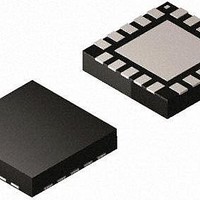MAX2042ETP+ Maxim Integrated Products, MAX2042ETP+ Datasheet - Page 24

MAX2042ETP+
Manufacturer Part Number
MAX2042ETP+
Description
RF Mixer HI-LIN 2000-3000MHZ W/LO BUFFER
Manufacturer
Maxim Integrated Products
Datasheet
1.MAX2042ETP.pdf
(27 pages)
Specifications of MAX2042ETP+
Frequency Range
1800 MHz to 3000 MHz
Maximum Conversation Loss
7.2 dB
Maximum Operating Frequency
3000 MHz
Maximum Operating Temperature
+ 85 C
Maximum Power Dissipation
5 W
Minimum Operating Temperature
- 40 C
Mounting Style
SMD/SMT
Operating Supply Voltage
5 V
Supply Current
138 mA
Package / Case
TQFN-20
Noise Figure
7.3 dB
Rf Type
General Purpose
Supply Voltage Range
3V To 5.25V
Rf Ic Case Style
QFN
No. Of Pins
20
Operating Temperature Range
-40°C To +85°C
Peak Reflow Compatible (260 C)
Yes
Rohs Compliant
Yes
Leaded Process Compatible
Yes
Lead Free Status / RoHS Status
Lead free / RoHS Compliant
SiGe High-Linearity, 2000MHz to 3000MHz
Upconversion/Downconversion Mixer with LO Buffer
When used as a low-side LO injection mixer in the
2300MHz to 2900MHz band, the MAX2042 provides
+36dBm of IIP3, with typical noise figure and conver-
sion loss values of only 7.3dB and 7.2dB, respectively.
The integrated baluns and matching circuitry allow for
50I single-ended interfaces to the RF and the LO ports.
The integrated LO buffer provides a high drive level to
the mixer core, reducing the LO drive required at the
MAX2042’s input to a -3dBm to +3dBm range. The IF
port incorporates a differential interface, which is ideal
for providing enhanced 2RF - 2LO performance.
Specifications are guaranteed over broad frequency
ranges to allow for use in WCS, LTE, WiMAX, and MMDS
base stations. The MAX2042 is specified to operate over
an RF input range of 2000MHz to 3000MHz, an LO range
of 1800MHz to 2800MHz, and an IF range of 50MHz to
500MHz. The external IF transformer sets the lower fre-
quency range (see the Typical Operating Characteristics
for details). Operation beyond these ranges is possible
(see the Typical Operating Characteristics for additional
information).
The MAX2042 RF input provides a 50I match when
combined with a series DC-blocking capacitor. This
DC-blocking capacitor required as the input is internally
DC shorted to ground through the on-chip balun. When
using an 8.2pF DC-blocking capacitor, the RF port input
return loss is typically 15dB over the RF frequency range
of 2500MHz to 2900MHz.
The MAX2042 is optimized for low-side LO injection
applications with an 1800MHz to 2800MHz LO frequency
range. The LO input is internally matched to 50I, requir-
ing only a 2pF DC-blocking capacitor. A two-stage
internal LO buffer allows for a -3dBm to +3dBm LO input
power range. The on-chip low-loss balun, along with an
LO buffer, drives the double-balanced mixer. All interfac-
ing and matching components from the LO inputs to the
IF outputs are integrated on-chip.
The core of the MAX2042 is a double-balanced, high-
performance passive mixer. Exceptional linearity is pro-
vided by the large LO swing from the on-chip LO buffer.
IIP3, 2RF - 2LO rejection, and noise-figure performance
are typically +36dBm, 70dBc, and 7.3dB, respectively.
24
_____________________________________________________________________________________
LO Inputs, Buffer, and Balun
Detailed Description
RF Interface and Balun
High-Linearity Mixer
The MAX2042 has an IF frequency range of 50MHz to
500MHz, where the low-end frequency depends on the
frequency response of the external IF components.
The MAX2042’s differential ports are ideal for providing
enhanced 2RF - 2LO performance. The user can use
a differential IF amplifier or SAW filter on the mixer IF
port, but a DC block is required on both IF+/IF- ports to
keep external DC from entering the IF ports of the mixer.
Typical applications typically use a 1:1 transformer such
as the MABAES0029 to transform the 50I differential
interface to a 50I single-ended interface. The loss of
this transformer is included in the data presented in this
data sheet. In addition, the IF interface directly supports
single-ended AC-coupled signals into or out of IF+ by
shorting IF- to ground, and a 1kI resistor from IF+ to
ground.
The RF input provides a 50I match when combined with
a series DC-blocking capacitor. Use an 8.2pF capaci-
tor value for RF frequencies ranging from 2000MHz to
3000MHz. The LO input is internally matched to 50I;
use a 2pF DC-blocking capacitor to cover operations
spanning the 1800MHz to 2800MHz range. The IF output
impedance is 50I (differential). For evaluation, an exter-
nal low-loss 1:1 (impedance ratio) balun transforms this
impedance down to a 50I single-ended output (see the
Typical Application Circuit).
The MAX2042 has one pin (LOBIAS) that allows an exter-
nal resistor to set the internal bias current. A nominal
value for this resistor is shown in Tables 1 and 2. Larger
value resistors can be used to reduce power dissipa-
tion at the expense of some performance loss. See the
Typical Operating Characteristics to evaluate the power
vs. performance tradeoff. If Q1% resistors are not readily
available, substitute with Q5% resistors.
Significant reductions in power consumption can also be
realized by operating the mixer with an optional supply
voltage of +3.3V. Doing so reduces the overall power
consumption by up to 43%. See the +3.3V Supply AC
Electrical Characteristics table and the relevant +3.3V
curves in the Typical Operating Characteristics section
to evaluate the power vs. performance tradeoffs.
Applications Information
Input and Output Matching
Differential IF Interface
Reduced-Power Mode









